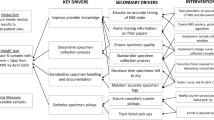Abstract
Objectives This study aimed to determine which steps in the newborn screening collection and delivery processes contribute to delays and identify strategies to improve timeliness. Methods Data was analyzed from infants (N = 94,770) who underwent newborn screening at 83 hospitals in Michigan between April 2014 and March 2015. Linear mixed effects models estimated effects of hospital and newborn characteristics on times between steps in the process, whereas simulation explored how to improve timeliness through adjustments to schedules for the state laboratory and for specimen pickup from hospitals. Results Time from collection to receipt of arrival to the state laboratory varied greatly with collection timing (P < 0.001), with specimens collected on Friday or Saturday delayed an average of 9–12 h compared to other specimens. Simulation estimates shifting specimen pickup from 6 p.m. Sunday–Friday to 9 p.m. Sunday–Friday could lead to an additional 12.6% of specimens received by the Michigan laboratory within 60 h of birth. Conclusions for Practice The time between when a specimen is collected and received by the laboratory can be a significant bottleneck in the newborn screening process. Modifying hospital pickup schedules appears to be a simple way to improve timeliness.


Similar content being viewed by others
References
American College of Medical Genetics Newborn Screening Expert Group. (2006). Newborn screening: Toward a uniform screening panel and system–executive summary. Pediatrics, 117, S296.
Bailey, D. B., & Gehtland, L. (2015). Newborn screening: Evolving challenges in an era of rapid discovery. JAMA, 313(15), 1511–1512.
Bocchini, J. (2015). Timeliness of Newborn Screening: Recommendations from the Secretary’s Descretionary Advisory Committee on Heritable Disorders in Newborns and Children, Letter to Secretary Burwell. Retrieved June 2016, from http://www.hrsa.gov/advisorycommittees/mchbadvisory/heritabledisorders/recommendations/timelynewbornscreeninggoalschainletter.pdf.
Centers for Disease Control, Prevention. (2012). CDC grand rounds: Newborn screening and improved outcomes. MMWR. Morbidity and Mortality Weekly Report, 61(21), 390–393.
Clinical and Laboratory Standards Institute. (2013). Blood collection on filter paper from newborn screening. Wayne, PA: Clinical and Laboratory Standards Instistute.
Gabler, E. (2013). Deadly delays: Delays at hospitals across the country undermine newborn screening programs, putting babies at risk of disability and death. Milwaukee Journal Sentinel.
Groves, T. M., Robinson, P., & Fitzgerald, D. A. (2015). Stratifying cystic fibrosis risk for newborn screen infants with equivocal sweat chloride levels. Pediatrics, 136(5), e1490.
Jiang X., Sidhu, R., Mydock-McGrane, L., Hsu, F. F., Covey, D. F., Scherrer, D. E., et al. (2016). Development of a bile acid-based newborn screen for Niemann-Pick disease type C. Science Translational Medicine, 8(337), 337–363.
Kelton, WD & Law, A. L. (2000). Simulation modeling and analysis. Boston: McGraw Hill.
Kim, S. H. & Whitt, W. (2014). Are call center and hospital arrivals well modeled by nonhomogeneous poisson processes? Manufacturing & Service Operations Management, 16(3), 464–480.
Kohn, L. T. & Corrigan, J. (2000). To err is human: Building a safer health system (Vol. 6). Washington DC: National Academies Press.
Maglio, P. P., Sepulveda, M. J., & Mabry, P. L. (2014). Mainstreaming modeling and simulation to accelerate public health innovation. American Journal of Public Health, 104(7), 1181–1186.
Secretary’s Discretionary Advisory Committee on Heritable Disorders in Newborns. (n.d.). Children Recommendations & Responses from the HHS Secretary. Retrieved June 2016, from Health Care Reform net: http://www.hrsa.gov/advisorycommittees/mchbadvisory/heritabledisorders/recommendations/index.html.
Young, T., Brailsford, S., Connell, C., Davies, R., Harper, P., & Klein, J. H. (2004). Using industrial processes to improve patient care. British Medical Journal, 328(7432), 162–164.
Author information
Authors and Affiliations
Corresponding author
Ethics declarations
Conflict of interest
The authors declare that they have no conflict of interest.
Electronic Supplementary material
Below is the link to the electronic supplementary material.
Rights and permissions
About this article
Cite this article
Cochran, A.L., Tarini, B.A., Kleyn, M. et al. Newborn Screening Collection and Delivery Processes in Michigan Birthing Hospitals: Strategies to Improve Timeliness. Matern Child Health J 22, 1436–1443 (2018). https://doi.org/10.1007/s10995-018-2524-z
Published:
Issue Date:
DOI: https://doi.org/10.1007/s10995-018-2524-z




